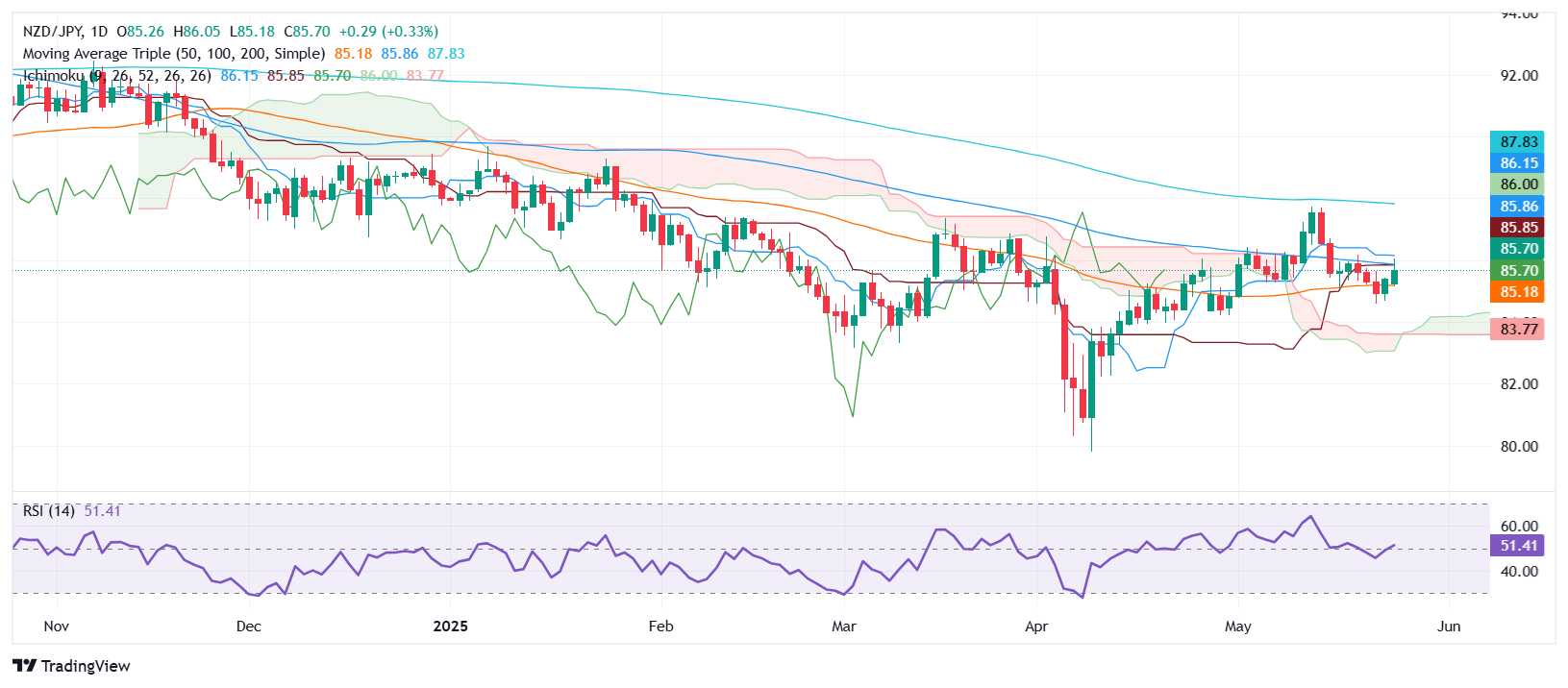NZD/JPY Price Forecast: Edges higher on holiday trade, bulls to face key hurdles
- NZD/JPY trades sideways, with momentum neutral as RSI hovers at the 50 mark.
- Bulls need to clear 86.00 to target 87.73 and YTD high at 89.71.
- Break below 84.61 could expose support near 83.50 at top of Kumo.
NZD/JPY begins the week on a positive note after registering a gain of over 0.42% on Monday amid thin liquidity conditions, as the US and UK financial markets remained closed for a holiday. In the meantime, as Tuesday’s Asian session begins, the cross-pair trades at 85.57, down 0.13% at the time of writing.
NZD/JPY Price Forecast: Technical outlook
The NZD/JPY trades sideways from a technical perspective, even though the Ichimoku Cloud (Kumo) analysis shows the pair is also tilted to the upside. This is because price action is above the Kumo, though capped on the upside by the Tenkan-sen at 85.67.
Momentum suggests that neither buyers nor sellers are in charge, with the Relative Strength Index (RSI) remaining at the 50-neutral line.
For a bullish scenario, the NZD/JPY needs to clear the Tenkan-sen and the 86.00 figure so buyers could challenge the latest cycle high of the May 13 high at 87.73. A decisive break will expose the year-to-date (YTD) peak at 89.71.
Conversely, for a bearish scenario to unfold, the NZD/JPY must clear the May 22 low of 84.61. If surpassed, the next support would be the top of the Kumo at around 83.50-83.75.
NZD/JPY Price Chart – Daily

New Zealand Dollar FAQs
The New Zealand Dollar (NZD), also known as the Kiwi, is a well-known traded currency among investors. Its value is broadly determined by the health of the New Zealand economy and the country’s central bank policy. Still, there are some unique particularities that also can make NZD move. The performance of the Chinese economy tends to move the Kiwi because China is New Zealand’s biggest trading partner. Bad news for the Chinese economy likely means less New Zealand exports to the country, hitting the economy and thus its currency. Another factor moving NZD is dairy prices as the dairy industry is New Zealand’s main export. High dairy prices boost export income, contributing positively to the economy and thus to the NZD.
The Reserve Bank of New Zealand (RBNZ) aims to achieve and maintain an inflation rate between 1% and 3% over the medium term, with a focus to keep it near the 2% mid-point. To this end, the bank sets an appropriate level of interest rates. When inflation is too high, the RBNZ will increase interest rates to cool the economy, but the move will also make bond yields higher, increasing investors’ appeal to invest in the country and thus boosting NZD. On the contrary, lower interest rates tend to weaken NZD. The so-called rate differential, or how rates in New Zealand are or are expected to be compared to the ones set by the US Federal Reserve, can also play a key role in moving the NZD/USD pair.
Macroeconomic data releases in New Zealand are key to assess the state of the economy and can impact the New Zealand Dollar’s (NZD) valuation. A strong economy, based on high economic growth, low unemployment and high confidence is good for NZD. High economic growth attracts foreign investment and may encourage the Reserve Bank of New Zealand to increase interest rates, if this economic strength comes together with elevated inflation. Conversely, if economic data is weak, NZD is likely to depreciate.
The New Zealand Dollar (NZD) tends to strengthen during risk-on periods, or when investors perceive that broader market risks are low and are optimistic about growth. This tends to lead to a more favorable outlook for commodities and so-called ‘commodity currencies’ such as the Kiwi. Conversely, NZD tends to weaken at times of market turbulence or economic uncertainty as investors tend to sell higher-risk assets and flee to the more-stable safe havens.


